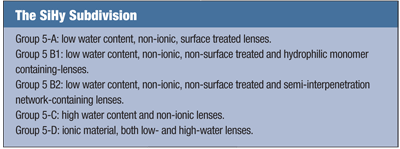 We do not like to think of contact lenses as vehicles of infection, but the truth is that they often deliver microbes to the eye. We know that colonized lenses are present in wearers both symptomatic and asymptomatic of inflammatory and microbial keratitis events.1 Therefore, managing the microbial load is vital to maintaining a healthy eye.
We do not like to think of contact lenses as vehicles of infection, but the truth is that they often deliver microbes to the eye. We know that colonized lenses are present in wearers both symptomatic and asymptomatic of inflammatory and microbial keratitis events.1 Therefore, managing the microbial load is vital to maintaining a healthy eye.
Lenses need to be cleaned of debris and deposits, and should maintain a wettable, biocompatible surface. But silicone hydrogel (SiHy) lenses present different concerns for contact lens/solution management than hydrogel lenses, and the FDA is now looking at ways to more effectively test this modality.http://opticalcms.jobson.com/CMS/tabid/152/ctl/edit_content/mid/578/content_type/1/Default.aspx
Silicone Hydrogels
The complexities of how microorganisms adhere to SiHy materials can be traced back to the physiochemical properties of the lens. For solution testing, the FDA currently categorizes SiHy with hydrogel materials. However, there are differing amounts of lipid and protein deposition, absorption of surfactants, and preservative uptake and release in SiHy vs. hydrogel lenses (and even between different SiHy lenses) that may affect microbial disinfection, lens safety and comfort.
 Many microbes form biofilms on lenses and in lens cases. Biofilm-forming bacteria have altered phenotypes and may promote the ability of bacteria to cause microbial keratitis. Some studies have shown that a greater number of bacteria adhere to silicone hydrogel lenses than their hydrogel counterparts. While SiHy lenses do not necessarily have increased adhesion to fungi (e.g., Fusarium solani), penetration into the lens does occur more rapidly on some silicone hydrogel lenses vs. hydrogels.1
Many microbes form biofilms on lenses and in lens cases. Biofilm-forming bacteria have altered phenotypes and may promote the ability of bacteria to cause microbial keratitis. Some studies have shown that a greater number of bacteria adhere to silicone hydrogel lenses than their hydrogel counterparts. While SiHy lenses do not necessarily have increased adhesion to fungi (e.g., Fusarium solani), penetration into the lens does occur more rapidly on some silicone hydrogel lenses vs. hydrogels.1
In short, microorganisms need to be tested differently on SiHy lenses than on hydrogels.
The ideal contact lens solution would be able to remove deposits, kill biofilm-forming microbes, increase surface wetting and also be well-tolerated by the ocular surface. Silicone hydrogel lenses are problematic because their chemical properties and surface treatments/hydrophobicity are so unique. The only definite way to determine deleterious lens/solution interactions would be to test each SiHy lens and solution combination separately. Certainly this would be both time consuming and cost prohibitive, particularly when you consider that new lenses and solutions are constantly under development.
The FDA Solution
As a result, the FDA set out to find a new way to look at solution/lens incompatibilities with three goals in mind: lower cost, increased safety and improved test predictability. It was concluded that preservative uptake and release is best predicted by water content and lens ionicity. Surface hydrophobicity adds an additional challenge to solution interactions. Based on these three properties, silicone hydrogel lenses have been subdivided into five categories (see “The SiHy Subdivsion”).2 The FDA will also begin to incubate materials with solutions to look for depleting disinfection levels, and add Acanthamoeba as a test organism.
Creating this new standard for SiHy disinfection was a joint effort between the FDA, consumers, industry, academia and other regulatory bodies. Through significant research it was determined that water content, ionicity, hydrophilicity and surface treatments were the key factors in determining lens/solution interactions. Hopefully, the new lens grouping will help ensure the safety of our patients and continue to allow new products to come to market in a timely fashion.
1. Willcox M. Microbial adhesion to silicone hydrogel lenses: a review. Eye Contact Lens. 2013 Jan;39(1):61-6.
2. Hutter J, Green A, Eydelman M. Proposed silicone hydrogel contact lens grouping system for lens care product compatibility testing. Eye Contact Lens. 2012 Nov;38(6):358-62.


